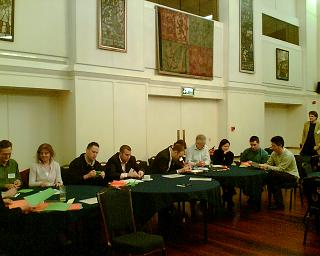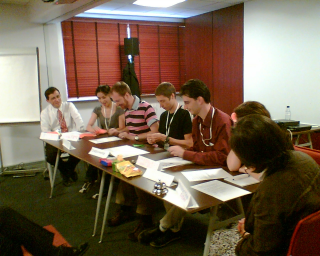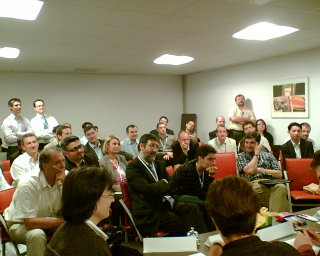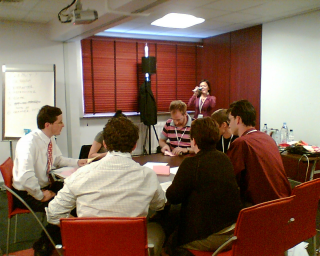The Story of Success
 Father Christmas brought me a large stack of books. First off is an easy read, the new Malcolm Gladwell book “Outliers: The Story of Success“. In the book, Gladwell tries to dig deep to explain the causes of unusually successful people, the outliers that are so far beyond the statistical norm that they seem magical.
Father Christmas brought me a large stack of books. First off is an easy read, the new Malcolm Gladwell book “Outliers: The Story of Success“. In the book, Gladwell tries to dig deep to explain the causes of unusually successful people, the outliers that are so far beyond the statistical norm that they seem magical.
Why do some people become hugely successful corporate lawyers, wealthy captains of industry, billionnaire IT entrepreneurs or hockey stars?
First of all, there’s talent. But talent isn’t enough. It takes effort, practice and hard training to develop that talent. Gladwell states that you need at least 10,000 hours of practice and illustrates the number with examples of The Beatles, Mozart, Bill Gates and Bill Joy.
But talent and practice by themselves are not enough to explain the cases Gladwell examines.
It’s not only who you are, but where you come from
For example, if you look at the month of birth of successful Canadian hockey players, the statistics show that most of them are born in the first months of the year. A few years ago I heard about the study that showed the same weird result for Belgian football players. Coincidence? Fluke? Is there something in the air in those months that gives babies an edge in sports? Gladwell doesn’t think so.
You see, there’s a cutoff date to select promising young players. That date happens to be the end of the year. The children who are born in january are just a few days too young to be eligible, so they have to wait until next year. By then, they are 11 months older than the eligible children born in December. They are stronger, smarter and have had more practice. They are more likely to stand out, get selected and profit from intensive training given to talented children.
A similar case can be made for successful IT entrepreneurs: they were all at the right age and in the right environment to profit from the availability of computer time to develop and apply their skills.
Held back by systemic constraints
In the case of the hockey players, it is likely that children born in December are (on average) as talented and hard working as those born in January. If they don’t get selected, a lot of talent and effort is wasted.
Gladwell calls the rate at which talents make it the “capitalisation rate”. The capitalisation rate for hockey players is lower than it could be. Why? Because of an arbitrary systemic constraint: the decision to select and sign young talents based on one cut off day. This effect is known and repeatable across the world. When the cut off date changes, the distribution of children is changed accordingly. We’ve all been subject to this systemic constraint because schools work with a fixed calendar.
Should we just accept those constraints?
Raising capitalisation rates
If we wish to raise the capitalisation rates, we need to tackle similar systemic constraints. One hopeful chapter describes how a school system improves the results of its pupils. First they notice the systemic constraint:
- children from richer backgrounds do better after the summer holiday as they have lots of stimulating activities;
- children from poorer backgrounds do worse after the summer holiday as their environment is much less stimulating.
The solution: less vacation and more school. Which also leads to more hours of practice, the second factor of success. Which leads to more opportunities to succeed and provide a stimulating environment to their children.
The chapter about plane crashes is chilling. The chapter contains several transcripts from cockpit conversations right before a crash. One common element comes back: the pilot makes a set of small mistakes and no one dares to speak up.
Some airlines have many more accidents than others. These statistics correlate with the culture of the country of the airline. Geert Hofstede has compiled a set of cultural dimensions for countries. One of the dimensions is “Uncertainty Avoidance”. A high score indicates a culture that doesn’t like ambiguity, relies on procedures and plans and is likely to stick to procedure regardless of circumstance. Another dimension is the “Power Distance Index”: a high score indicates that authority is very respected and a more powerful or knowledgeable person will not be questioned easily.
Do high Uncertainty Avoidance and Power Distance scores correlate with high numbers of airline incidents? Yes. If something goes wrong you want people to speak up and consider alternatives to the routine. Knowing this, training can take into account the differences. For example, techniques to lower the power distance can be taught and applied in the cockpit. Again, dealing with the systemic constraints brings dramatic improvements.
What have we learned today?
I got two lessons out of this book.
First, the capitalisation rate on our teams. It is sometimes said that “Agile only works with really good people and teams”. That’s true. But Agile also makes the people a lot better by providing them with a better environment, support and many learning opportunities. We create communities, conferences and help each other get better. We raise the capitalisation rates within IT. But we can do a lot more if we have the courage to tackle the systemic constraints. For example:
- Why are there fewer women than men in IT?
- Why is IT seen as a “young man’s game”? Why don’t we value experience more (and keep reinventing yesterday’s mistakes)? Don’t we need to put in our 10,000 hours to become proficient? Well, at least many of us put in many hours in death marches. I don’t know if that’s useful practice, though…
- Why the division into “Business” vs “IT”? Aren’t we in this together?
- Why the division into development, testing, maintenance, operations? Isn’t it all one value stream?
- <your favourite constraint here>.
What small thing can you do to raise the capitalisation rate?
Secondly, Belgium was used as an example of a country with a high “Uncertainty Avoidance” culture. Yeah, we’re great at creating little rules to organise everything. We’re also great at breaking the rules, because they keep us from doing any useful work. But nobody must know we broke the rule, because we’re also a culture with a very high “Power Distance Index”. In this, we’re quite similar to France. Now, that’s not a culture that’s naturally predisposed to accept Agile methods. Except maybe, when they’re introduced top-down and are very structured?
On the other hand, The Netherlands and Scandinavian countries have a much lower Uncertainty Avoidance and Power Distance Index score. One would expect that they would accept Agile methods more easily.
Have a look at the scores for your country. Do they correlate in any way with the success and ease of introducing Agile?
Watch Gladwell present some of the ideas in the book:



 We start the day with a refreshing run up the Champs Elysées, down to the Eiffel tower and along the Seine. I’ve been looking forward to this day: I will meet two of my heroes!
We start the day with a refreshing run up the Champs Elysées, down to the Eiffel tower and along the Seine. I’ve been looking forward to this day: I will meet two of my heroes!


 OCTO brought
OCTO brought